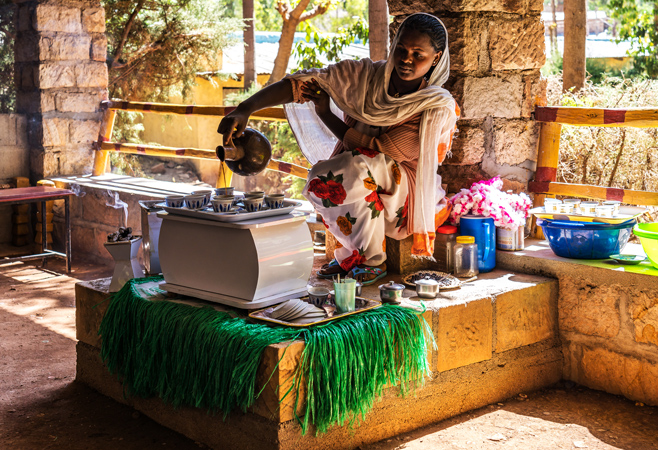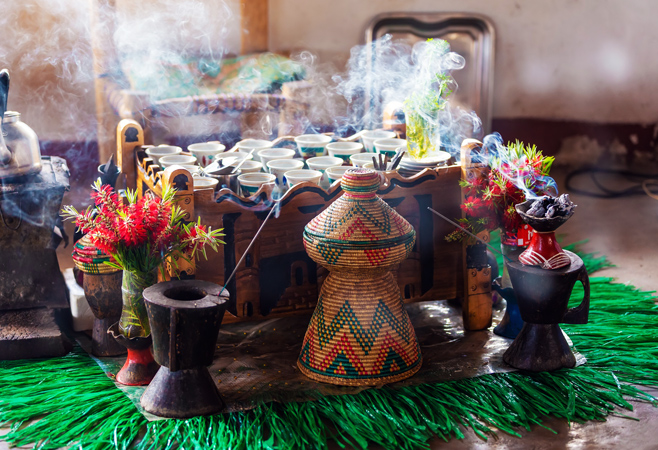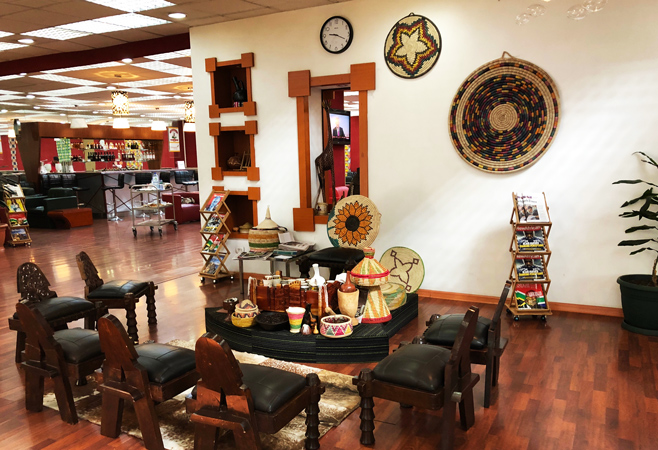- The Origins of Ethiopian Coffee
- What Is the Ethiopian Coffee Ceremony?
- The Setting and Atmosphere
- How to make an Ethiopian coffee ceremony?
- The Meaning Behind the Ritual
- Accompaniments and Traditions
- Where to Experience the Coffee Ceremony
- Why It’s a Must-Do for Travelers
- Practical Travel Tips For Travelers
- Conclusion
Experiencing the Ethiopian Coffee Ceremony as a Visitor
Coffee is more than a beverage in Ethiopia — it’s a symbol of hospitality, friendship, and tradition. The Ethiopian Coffee Ceremony is one of the country’s most cherished cultural experiences, reflecting the nation’s deep-rooted relationship with coffee, known locally as buna.
For travelers planning to visit Ethiopia, attending a traditional coffee ceremony offers a glimpse into the soul of Ethiopian culture — where time slows down, and people connect through aroma, conversation, and shared appreciation of life’s simple pleasures. Before you embark on this unforgettable journey, make sure to apply for your Ethiopia e-Visa and prepare to experience the country’s authentic traditions up close.
The Origins of Ethiopian Coffee
Ethiopia is widely regarded as the birthplace of coffee. According to legend, a 9th-century goat herder named Kaldi discovered coffee after noticing his goats became energetic after eating red berries from a certain tree. This ancient discovery in the Kaffa region (from which the word “coffee” originates) transformed global culture and trade forever.
Today, Ethiopia remains one of the world’s most famous coffee-producing nations, with diverse regional varieties such as Sidamo, Yirgacheffe, and Harrar, each offering distinctive aromas and flavors. However, it’s not just about drinking coffee — the Ethiopian Coffee Ceremony elevates it to an art form.
 A host carefully pouring hot coffee from a black clay jebena into small, handleless cups arranged neatly on a tray
A host carefully pouring hot coffee from a black clay jebena into small, handleless cups arranged neatly on a tray
What Is the Ethiopian Coffee Ceremony?
The Ethiopian Coffee Ceremony is a ritualized social and spiritual gathering, where coffee is prepared, brewed, and served in a traditional, multi-step process. It typically lasts one to two hours and is performed up to three times a day — morning, noon, and evening.
This ceremony represents respect, community, and hospitality. Being invited to a coffee ceremony is considered a sign of friendship and honor, making it an unmissable experience for any visitor to Ethiopia.
When It's Celebrated
The festival typically takes place in late September or early October, coinciding with the end of the rainy season when flowers bloom and the landscape is lush and green.
The Setting and Atmosphere
The ceremony often takes place in a living room or outdoor courtyard, where fresh grass or flowers are spread on the floor to symbolize purity and renewal. Incense such as frankincense or myrrh burns gently, creating an inviting and spiritual atmosphere.
Guests are seated as the hostess — usually dressed in traditional Ethiopian attire — begins the ritual. Every stage is performed slowly and with intention, emphasizing mindfulness and respect for the process.
 Traditional Ethiopian coffee ceremony setup
Traditional Ethiopian coffee ceremony setup
How to make an Ethiopian coffee ceremony?
The Ethiopian Coffee Ceremony follows several key stages, each rich with symbolism:
1. Roasting the Beans
Raw green coffee beans are washed and roasted over a charcoal stove in a flat pan (menkeshkesh). The hostess stirs the beans continuously until they turn a glossy dark brown, filling the room with an irresistible aroma. Guests are often invited to inhale the roasted beans’ fragrance, symbolizing a shared moment of appreciation.
2. Grinding the Beans
Once roasted, the beans are ground using a traditional mortar and pestle. This manual process releases the beans’ natural oils, producing a distinctively rich aroma that defines Ethiopian coffee.
3. Brewing in the Jebena
The powdered coffee is placed into a jebena — a black clay coffee pot with a round base and long spout. Water is added, and the mixture is brought to a slow boil over charcoal. The jebena’s unique shape allows the coffee to brew naturally, without losing its flavor or texture.
4. Pouring and Serving
The hostess pours the coffee gracefully from a height into small cups (sini), ensuring a delicate foam forms on top. It’s typically served three times — each round symbolizing a blessing:
- Abol – the first and strongest cup, representing strength.
- Tona – the second, signifying peace.
- Bereka – the third, meaning blessing and prosperity.
- Guests are encouraged to drink all three cups as part of the full ceremony.
 A beautiful Ethiopian coffee ceremony zone inside Addis Ababa Bole International Airport
A beautiful Ethiopian coffee ceremony zone inside Addis Ababa Bole International Airport
The Meaning Behind the Ritual
The Ethiopian Coffee Ceremony is more than an act of brewing — it’s a social and spiritual experience.
It brings families and neighbors together to discuss community matters, share stories, and celebrate life.
It embodies Ethiopian values of hospitality, respect, and unity.
It is also a moment for reflection and gratitude, connecting people not only to each other but to nature and tradition.
For travelers, it’s a chance to slow down and experience Ethiopia’s warm culture firsthand.
Accompaniments and Traditions
During the ceremony, coffee is often served with snacks such as:
- Kolo (roasted barley or corn)
- Popcorn
- Injera bites or small bread pieces
- Sugar may be added depending on regional customs, and in some rural areas, salt or butter replaces sugar for a distinctive local flavor.
 The host prepares and serves coffee
The host prepares and serves coffee
Where to Experience the Coffee Ceremony
You can experience an authentic Ethiopian Coffee Ceremony almost anywhere in the country — from traditional households to cultural restaurants and hotels. Top locations include:
- Addis Ababa: Many cultural restaurants, such as Yod Abyssinia or Habesha 2000, perform the ceremony for visitors.
- Lalibela and Gondar: You can enjoy intimate, family-led ceremonies in traditional homes.
- Harar (East): Known for the spiciest coffee; ceremonies often include cardamom.
- Jimma & Kaffa (Birthplace of coffee): Visit coffee farms and participate in rural rituals.
- Oromia and Sidamo Regions: Visit local farms to witness the process from bean to cup.
For a genuine experience, seek smaller local setups rather than tourist-oriented performances. Locals are often proud to share their traditions with respectful visitors.
Why It’s a Must-Do for Travelers
For travelers, attending a coffee ceremony is like stepping into Ethiopia’s living heritage. It’s not just about drinking coffee; it’s about experiencing a way of life where community and gratitude take center stage. The slow, rhythmic process stands in beautiful contrast to the fast pace of modern travel.
Participating in a traditional Ethiopian Coffee Ceremony is one of the most meaningful ways to connect with local culture, meet welcoming hosts, and discover the roots of the world’s favorite drink.
Practical Travel Tips For Travelers
If you’re invited to a coffee ceremony in Ethiopia:
- Accept the invitation — it’s a gesture of warmth and friendship.
- Dress modestly and comfortably, especially in rural or religious settings.
- Don’t rush—the ceremony is about conversation and presence. Traditional ceremonies are family-oriented and respectful.
- Use your right hand to accept the cup.
- Drink at least the first cup (abol) to show respect.
- Carry cash for small purchases or tips if the ceremony is held in a public venue. It is appreciated but not required in homes; 20–50 ETB is polite.
- Learn basic phrases in Amharic or Afaan Oromo to express gratitude — locals appreciate it. Compliment the hostess (“Bunna tirus yistilign” – “May the coffee be strong”).
- Book a guided tour to understand regional coffee traditions across Ethiopia’s coffee-producing zones.
Before You Go: Apply for Your Ethiopia e-Visa
To experience the beauty of Ethiopia’s coffee culture firsthand, ensure your travel is smooth and worry-free by applying for an Ethiopia e-Visa before your trip. The online visa process is fast and secure, allowing travelers to:
- Apply and pay online
- Receive visa approval via email
- Skip long queues at the airport upon arrival
Start your application today at Ethiopia Immigration Services and begin your journey toward an authentic Ethiopian adventure filled with aroma, culture, and warmth.
Conclusion
The Ethiopian Coffee Ceremony is more than a cultural experience — it’s a reflection of the country’s soul. Every step, from roasting to pouring, tells a story of hospitality, history, and connection. For travelers, it’s a moment to pause, reflect, and feel the heartbeat of Ethiopia.
Whether you’re exploring Addis Ababa’s bustling streets or the highlands of Sidamo, make sure to take part in this time-honored ritual — and remember to apply for your Ethiopia e-Visa before you go, so you can immerse yourself in the world’s most authentic coffee culture without any hassle.
Related Articles
- Top Active Volcanoes in Ethiopia You Must See
- Exploring Dorze Village: What to See and Do
- Top Travel Apps for Visiting Ethiopia
- Top Destinations for Historic Holidays in Northern Ethiopia
- Ethiopia Entry Requirements for African Travelers
- Bole Addis Ababa International Airport: What Travelers Need to Know
- Exploring the Gheralta Rock Churches of Ethiopia
- Ethiopian Highlands Travel Tips: Things Must See & Do
- Travel From Eritrea to Ethiopia: What Tourists Need to Know





